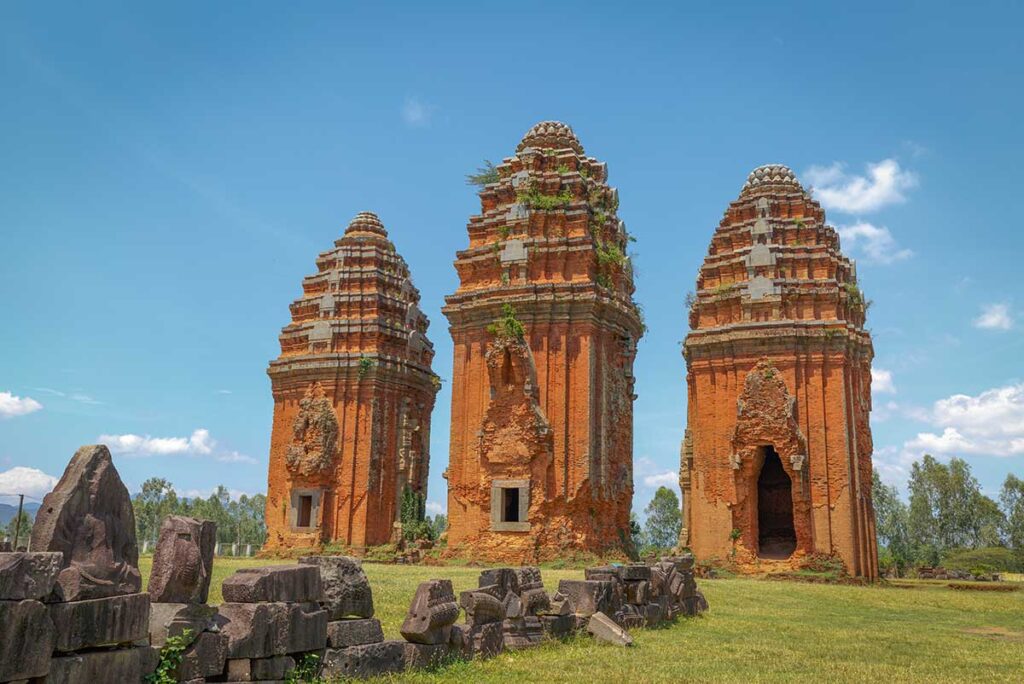What are the Duong Long Cham Towers?
The Duong Long Cham Towers are a group of three brick sanctuaries standing on a low hill in Tây Sơn District, Binh Dinh Province. All three towers face east, with the central tower rising higher than its two flanking counterparts. What makes the complex unusual compared to most Cham architecture is the extensive use of sandstone: doorframes, corners, and decorative bands are carved from massive stone blocks rather than just brick.
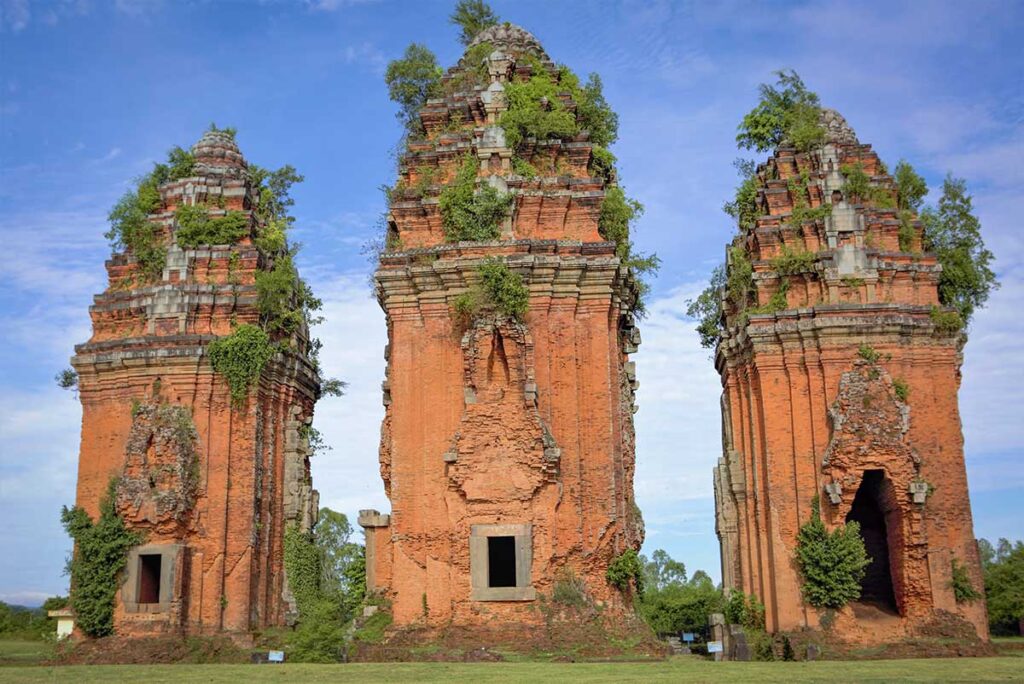
The towers date back to the Vijaya period of the Cham kingdom, when Binh Dinh was its political and cultural center. This site is considered one of the most important Cham monuments from that era, with the central tower often cited as the tallest surviving Cham brick tower in Vietnam—or even Southeast Asia, depending on how measurements are reported.
Over the centuries, the site has been known by different names. Locally it has been referred to as Van Tuong or An Chanh Towers, while French colonial scholars called it the Tour d’Ivoire (“Ivory Towers”). Today, Duong Long remains a key place to understand both the scale of Cham architecture and the blend of brick and stone techniques that make it stand out.
Cham background in brief
The Cham were an influential people who established the kingdom of Champa, stretching along much of Vietnam’s central coast for more than a thousand years. Binh Dinh Province was once home to Vijaya, the political and cultural capital of the kingdom during its later centuries. This period saw major construction projects, including some of the tallest and most ambitious Cham towers still standing today.
One striking feature of Duong Long is its abundant use of sandstone. Most Cham towers across Vietnam are built almost entirely from brick, with only limited stone decoration. Here, however, stone plays a much larger role, from carved lintels to cornerstones decorated with lions, elephants, naga serpents, and dancers. Scholars often point to Khmer influence, as the Khmer Empire and Cham polities were in regular contact at the time.
The towers are generally linked to Hindu traditions, possibly representing the Trimurti of Shiva, Vishnu, and Brahma. Yet there are also theories that Duong Long may have had Buddhist or Tantric significance, influenced by religious currents from neighboring Cambodia. Because original statuary is missing, no single interpretation has been confirmed, leaving the site’s exact ritual purpose somewhat open to debate.
History of the Duong Long Cham Towers
The Duong Long Towers were constructed in the late 12th to early 13th century, at the height of Vijaya’s power. Their scale and decoration reflect both the resources and craftsmanship available to the Cham elite of the time.
Like many ancient monuments, the towers have suffered from centuries of neglect and human impact. Local accounts mention treasure hunters digging into the structures, and villagers in earlier times even reused bricks for their own buildings. Combined with natural weathering and damage from wars, these pressures left the complex fragile in many areas.
Despite this, Duong Long survived as one of the most monumental Cham sites in Vietnam. In recognition of its value, the towers were classified as an Architectural Art Monument in 1980, and later elevated to the status of a Special National Relic in 2015.
Restoration and preservation have been ongoing, but progress has been uneven. A recent large-scale project, with a budget of over 93 billion VND, has focused on stabilizing the southern and central towers from their base up to 12 meters high. Alongside this, archaeologists have been conducting a 9,000 m² excavation around the site, uncovering more about its layout and surrounding structures. While some scaffolding and construction areas can affect the visitor experience, these efforts are essential to ensure the towers remain standing for future generations.
Architecture & Art: how to read the site today
1. Site plan & orientation

The Duong Long complex is straightforward in layout: three towers built in a row, aligned north to south, with all entrances facing east. This orientation follows Cham religious convention, with doors opening toward the rising sun. Archaeological traces suggest the central tower once had a projecting porch or mandapa, now long collapsed. Remains of other brick foundations west and south of the towers indicate there may have been secondary structures, possibly altars or auxiliary shrines.
2. Heights, tiers & the “tallest” claim (and the numbers problem)

The central tower is widely cited at about 39 meters high, flanked by two smaller towers of roughly 33 and 32 meters. However, some English-language sources list lower figures (24 and 22 meters), likely due to differences in measurement methods—whether including foundations and roof tiers or only the main brick body. Despite the conflicting numbers, there is consensus that Duong Long’s central tower is the tallest surviving Cham brick tower in Vietnam, and possibly in all of Southeast Asia.
3. Brick vs sandstone
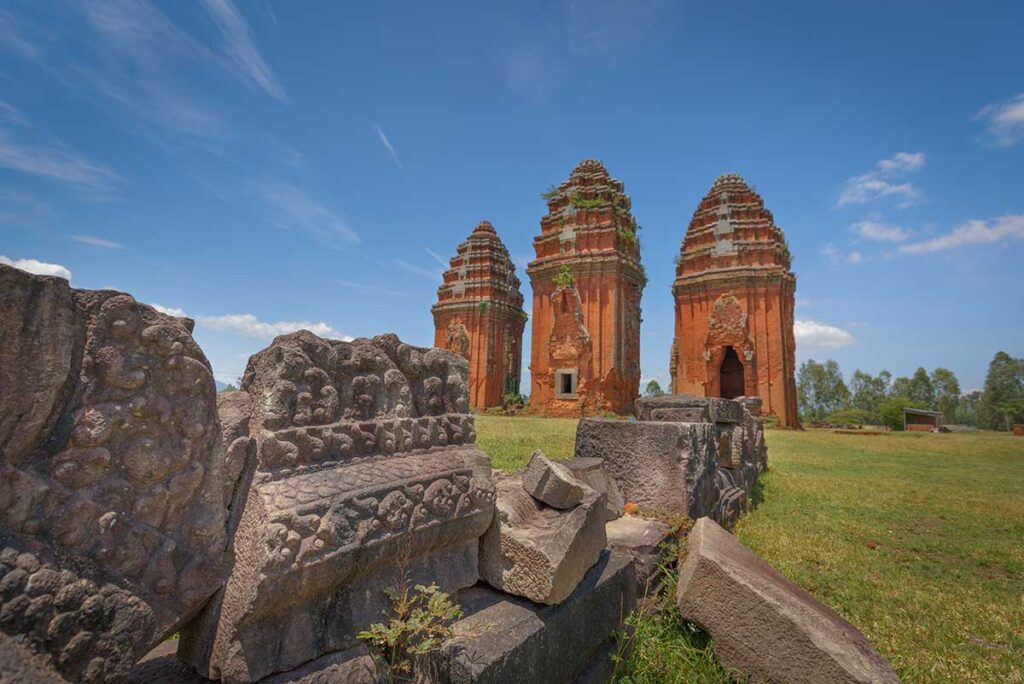
Most Cham towers across Vietnam are overwhelmingly brick, with sandstone reserved for a few decorative details. Duong Long breaks this pattern: large sections of the corners, lintels, archivolts, and decorative friezes are carved from sandstone blocks. The abundance of stone carving, both structural and ornamental, has led scholars to suggest Khmer influence, as Khmer builders favored massive stone decoration. The visual effect is striking—brick for the soaring body of the towers, stone for the intricate details.
4. Carved imagery to spot

Although weathering and past damage mean that many carvings are incomplete, visitors can still identify key motifs. Look for gaja-simha (mythical lion-elephant hybrids), makara (sea monsters), naga serpents, and kala faces, all common protective symbols. Lotus petals and garlands frame openings, while dancers and seated human figures appear in relief on sandstone blocks. Scholars link these motifs to Hindu traditions, possibly representing the Trimurti—Shiva, Vishnu, and Brahma—though the absence of original statuary means no single interpretation is certain.
5. Individual towers (concise)
- Central Tower – The tallest and most imposing, once fronted by a large projecting porch. Its four-tiered roof structure still gives a sense of upward momentum.
- South Tower – The best preserved, with stepped recess walls and a decorative band of gaja-simha figures that are still visible.
- North Tower – Rich in sandstone carvings, including lions, dancers, and seated figures, but more heavily eroded and visibly weathered than the others.
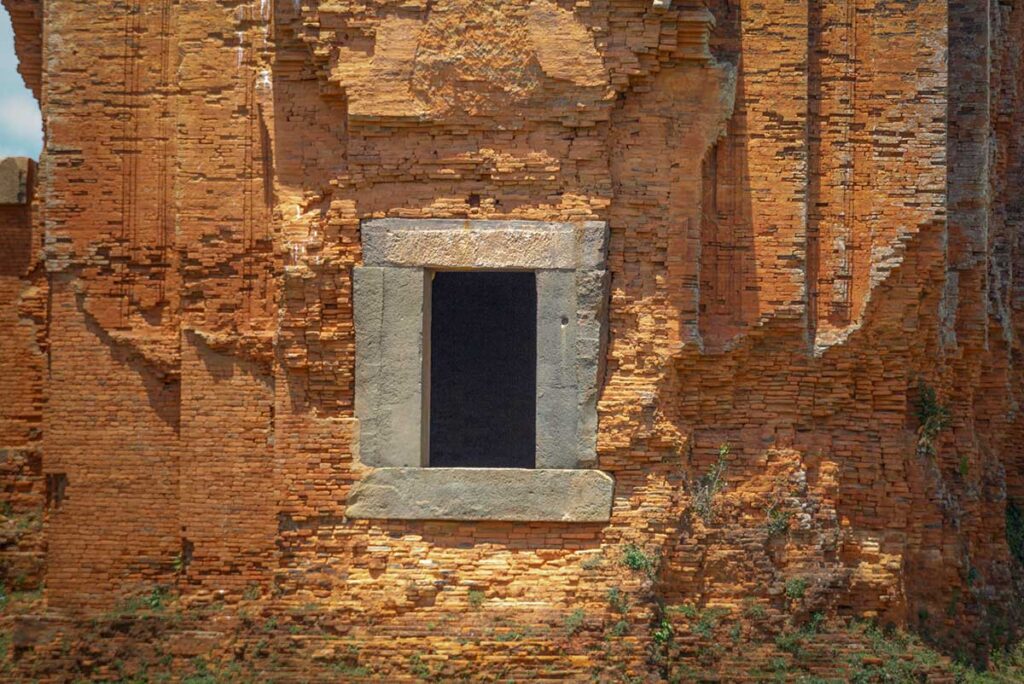
Together, these towers balance grandeur with detail: brick massing for scale and sandstone carving for texture and artistry. Even in partial ruin, they remain some of the most architecturally ambitious monuments of Cham heritage.
Location & getting there
Where are the Duong Long Cham Towers?
The Duong Long Cham Towers are located in Binh An Commune, Tây Sơn District, Binh Dinh Province, about 35–50 km northwest of Quy Nhon, depending on your starting point in the city. The drive takes you out of the coastal plain and into quiet rural countryside, with the last stretch on small provincial roads. Signage is limited, but the towers stand on a low hill and are visible from a distance once you get close.
Car with driver (recommended)
For most travelers, hiring a car with driver from Quy Nhon is the easiest option. It gives you a fixed-price itinerary, no stress about navigation, and flexibility if the gate happens to be closed on arrival—a common occurrence at smaller Cham sites. Drivers are usually patient while you wait or call the guard, and you can combine the visit with other stops such as Banh It Towers or the Quang Trung Museum to make a full-day trip.
Motorbike from Quy Nhon
Adventurous travelers often ride here on motorbikes. The countryside roads are generally quiet, with only light traffic, though you may encounter the odd rough or uneven section. Officially, Vietnam requires an International Driving Permit (IDP) and the correct motorbike license to ride legally, though in practice many travelers rent without one. Still, be aware of the risks. If you do ride, set out early in the morning or late in the afternoon to avoid the heat, and carry water since there are few shops near the site.
Practical information & tips for visiting
Opening hours & entrance fees (and gate reality)
Officially, the towers keep a split schedule: mornings roughly 7:30–11:00 and afternoons 13:30–16:30. In practice, hours are not always consistent, and you may find the gate locked outside these times. Entry usually costs around 10,000–20,000 VND per person, though this too can vary slightly.
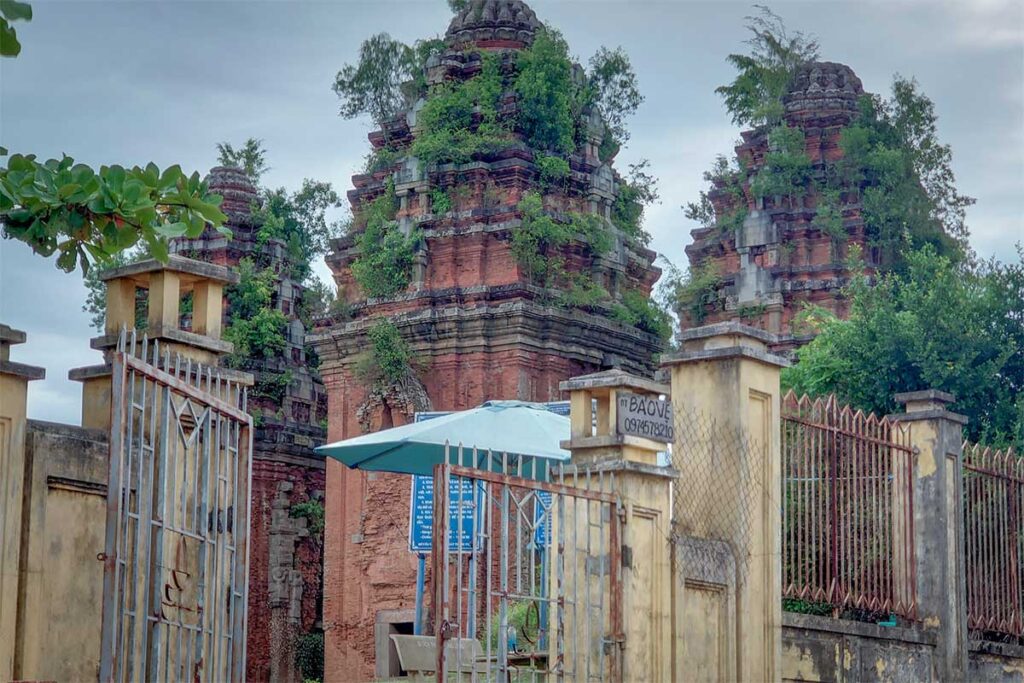
If the gate is closed, there is often a sign with a phone number for the guard, who can come and open it. Bring small cash and a bit of patience—this is not a high-traffic site with polished visitor services.
Best time to visit
The towers face east, so early morning light is beautiful for photography. Late afternoon is also comfortable, with long shadows that bring out the carvings. Avoid arriving around lunch, as the site typically closes between late morning and early afternoon. Since there’s little shade once you’re inside, bring water, a hat, and sunscreen.
Etiquette & safety
Duong Long is still undergoing preservation, so respect any barriers or scaffolding in place. Do not climb on the towers or touch loose stones, as some sections are fragile. Dress modestly out of respect for the site’s cultural and spiritual importance, and take care when walking around, as uneven ground and fallen blocks can be a tripping hazard.
Facilities
There are no real facilities at the towers themselves—no cafés, toilets, or souvenir shops. The nearest basic services are in Phu Phong town or other parts of Tây Sơn District, so it’s best to bring your own water and snacks. Plan your visit accordingly, especially if traveling with children.
For Cham enthusiasts
If Duong Long sparks your interest, you can deepen your understanding at the Binh Dinh Museum in Quy Nhon, which holds Cham sculptures and artifacts found in the region. It’s not a long stop but gives valuable context, showing carvings and statues similar to those that once adorned the towers.
Current restoration status

The towers are part of an ongoing preservation project worth over 93 billion VND, which includes both structural reinforcement and archaeological excavation of about 9,000 m² around the site. As a visitor, this means you may encounter scaffolding or partially closed areas, depending on the stage of work. These efforts are essential to protect the towers, but if seeing them fully clear of construction is important to you, check the latest status before planning a visit.
What is nearby or on the way?
Duong Long Cham Towers are impressive, but the visit itself is fairly short. On their own, they don’t justify a full-day trip from Quy Nhon unless you combine them with other sights. The towers make the most sense to include on a day focused on Cham heritage or Tay Son history, or if you are driving the longer route between Pleiku (Gia Lai) and Quy Nhon, where they fall naturally along the way.
- Quang Trung Museum (Phu Phong) – Located just a short drive away, this museum is dedicated to Nguyễn Huệ, better known as Emperor Quang Trung, one of Vietnam’s most celebrated military leaders. It pairs well with Duong Long, giving a contrasting look at Cham antiquity and 18th-century history in the same day.
- Banh It Towers – If you’re coming from Quy Nhon, you’ll likely pass near Banh It, one of the finest Cham tower groups in Binh Dinh. Its hilltop setting and well-preserved architecture make it one of the best-known Cham sites in the province and a natural stop on a Cham-focused loop.
- Tay Son Heaven Forum – A smaller local site tied to Tay Son history. It’s not essential, but if you’re already in the area and interested in rounding out the story of the Tay Son uprising, it can be added to your itinerary.
For most travelers, Duong Long works best as part of a combined route—Cham towers, a museum stop, and a bit of Tay Son history—rather than a standalone outing.
Are the Duong Long Cham Towers worth visiting?
If you’re interested in Cham history or architecture, Duong Long is one of the most impressive sites you can see in Vietnam. The sheer height of the central tower, the unusual amount of sandstone carving, and the quiet countryside setting make it both architecturally outstanding and atmospheric.
That said, the site is remote and has very limited facilities—no cafés, toilets, or much signage. Opening hours can be irregular, and with restoration works ongoing, you may find scaffolding or partial closures. For casual visitors just looking for a quick sightseeing stop, these factors can be frustrating.
The best way to appreciate Duong Long is as part of a broader day trip that also includes other Cham towers or the Quang Trung Museum. Seen in that context, it’s a rewarding stop that adds depth to a cultural loop around Quy Nhon and Tây Sơn. As a single-purpose excursion, however, it may feel too small or inconvenient.
